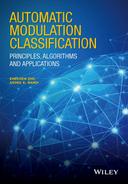Preface
Automatic modulation classification detects the modulation type of received signals to guarantee that the signals can be correctly demodulated and that the transmitted message can be accurately recovered. It has found significant roles in military, civil, intelligence, and security applications.
Analogue Modulations (e.g., AM and FM) and Digital Modulations (e.g., PSK and QAM) transform baseband message signals (of lower frequency) into modulated bandpass signals (of higher frequency) using a carrier signal for the purpose of enhancing the signal’s immunity against noise and extending the transmission range. Different modulations require different hardware configurations and bandwidth allocations. Meanwhile, they provide different levels of noise immunity, data rate, and robustness in various transmission channels. In order to demodulate the modulated signals and to recover the transmitted message, the receiving end of the system must be equipped with the knowledge of the modulation type.
In military applications, modulations can serve as another level of encryption, preventing receivers from recovering the message without knowledge of the modulation type. On the other hand, if one hopes to recover the message from a piece of intercepted and possibly adversary communication signal, a modulation classifier is needed to determine the modulation type used by the transmitter. Apart from retrieving the transmitted message, modulation classification is also useful for identifying the transmitting unit and to generate jamming signals with matching modulations. The process is initially implemented manually with experienced signal engineers and later automated with automatic modulation classification systems to extend the range of operable modulations and to improve the overall classification performance.
In modern civilian applications, unlike in much earlier communication systems, multiple modulation types can be employed by a signal transmitter to control the data rate, to control the bandwidth usage, and to guarantee the integrity of the message. Though the pool of modulation types is known both to transmitting and receiving ends, the selection of the modulation type is adaptive and may not be known at the receiving end. Therefore, an automatic modulation classification mechanism is required for the receiving end to select the correct demodulation approach in order to guarantee that the message can be successfully recovered.
This research monograph covers different algorithms developed for the automatic classification of communications signal modulation types. The theoretical signal models are explained in the first two chapters to provide the principles on which the analyses are based. An important step is to unify various signal models proposed in different studies and to provide a common framework for analysis of different automatic modulation classification algorithms.
This book includes the majority of the methods developed over the last two decades. The algorithms are systematically classified to five major categories: likelihood-based classifiers, distribution test-based classifiers, feature-based classifiers, machine learning-assisted classifiers, and blind modulation classifiers. For each type of automatic modulation classifier, the assumptions and system requirements are listed, and the design and implementation are explained through mathematical expressions, graphical illustrations and programming pseudo codes. Performance comparisons among several automatic modulation classifiers from each category are presented with both theoretical analysis and simulated numerical experiments. MATLAB® source code of selected methods will be available on https://code.google.com/p/amc-toolbox/.
The accumulated knowledge on the principle of automatic modulation classification and the characteristics of different automatic modulation classification algorithms is used to suggest the detailed implementation of modulation classifiers in specific civilian and military applications.
As the field is still developing, such a book cannot be definitive or complete. Nonetheless it is hoped that graduate students should be able to learn enough basics before studying journal papers; researchers in related fields should be able to get a broad perspective on what has been achieved; and current researchers as well as engineers in this field should be able to use it as a reference.
A work of this magnitude will unfortunately contain errors and omissions. We would like to take this opportunity to apologise unreservedly for all such indiscretions in advance. We welcome any comments or corrections; please send them by email to [email protected] or by any other means.
Zhechen Zhu and Asoke K. Nandi
London, UK
